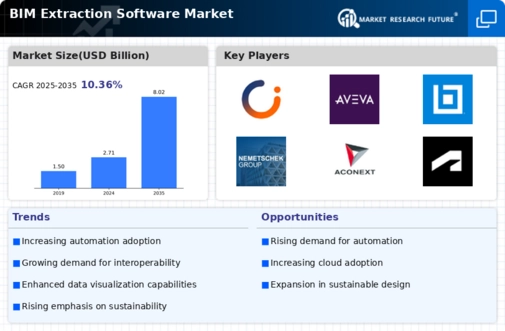Regulatory Compliance and Standards
Regulatory compliance is a critical driver for the BIM Extraction Software Market. As governments and regulatory bodies implement stricter building codes and standards, the need for software that ensures compliance becomes paramount. BIM extraction tools facilitate adherence to these regulations by providing accurate data extraction and reporting capabilities. This trend is underscored by the increasing number of jurisdictions mandating BIM for public projects, which has led to a surge in software adoption. The market is likely to see a compound annual growth rate of 15% as firms invest in solutions that not only meet compliance requirements but also enhance overall project quality.
Rise of Collaborative Work Environments
The rise of collaborative work environments is significantly influencing the BIM Extraction Software Market. As teams become more dispersed, the need for software that facilitates real-time collaboration and information sharing is paramount. BIM extraction tools that support multi-user access and cloud integration are increasingly sought after, as they allow stakeholders to work together seamlessly, regardless of location. This trend is evident in the construction sector, where collaborative platforms are projected to grow by 25% over the next five years. The ability to extract and share data efficiently enhances teamwork and project outcomes, making these tools indispensable in modern construction practices.
Growing Emphasis on Data-Driven Decision Making
The emphasis on data-driven decision making is reshaping the BIM Extraction Software Market. Organizations are increasingly recognizing the value of data analytics in optimizing construction processes. BIM extraction software enables users to harness vast amounts of data generated during the design and construction phases, leading to improved insights and strategic planning. This trend is supported by the fact that companies utilizing data analytics report up to 20% higher project success rates. As the industry continues to evolve, the integration of advanced analytics within BIM extraction tools is expected to become a standard practice, further driving market growth.
Increased Demand for Efficient Project Management
The BIM Extraction Software Market is experiencing heightened demand for tools that enhance project management efficiency. As construction projects grow in complexity, stakeholders seek solutions that streamline workflows and improve collaboration. This demand is reflected in the projected growth of the BIM software market, which is expected to reach USD 10 billion by 2026. The ability to extract and analyze data from Building Information Models (BIM) allows project managers to make informed decisions, reducing delays and cost overruns. Consequently, the integration of advanced BIM extraction software is becoming essential for firms aiming to maintain competitiveness in a rapidly evolving industry.
Advancements in Artificial Intelligence and Machine Learning
Advancements in artificial intelligence (AI) and machine learning (ML) are poised to transform the BIM Extraction Software Market. These technologies enable software to automate data extraction processes, improving accuracy and efficiency. AI-driven tools can analyze patterns and predict project outcomes, providing valuable insights that enhance decision-making. The integration of AI and ML is expected to drive a market growth rate of 18% annually, as firms seek to leverage these innovations for competitive advantage. As the industry embraces digital transformation, the demand for intelligent BIM extraction solutions will likely increase, reshaping how projects are managed and executed.


















Leave a Comment